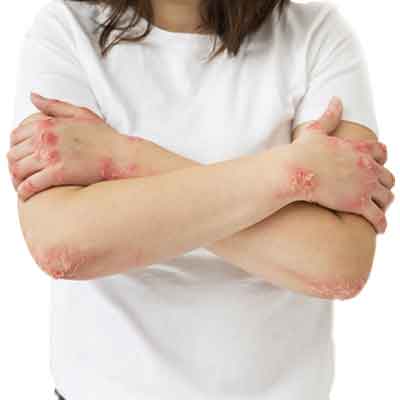Vitiligo
Because your skin deserves the best care
Home » Vitiligo
Vitiligo
Welcome to our dedicated page for dermatology in Edmonton. We’re here to provide valuable insights into understanding and managing this skin condition. Vitiligo causes depigmentation, resulting in white patches on the skin. Our Edmonton center offers resources to help you navigate this condition, offering information on causes, treatments, and coping strategies. With a focus on education and support, we aim to empower you to make informed decisions about managing Vitiligo and achieving confidence in your skin’s appearance. Explore our resources and embark on a journey to greater understanding and self-assurance.



Vitiligo is a skin disorder characterized by the loss of pigment-producing cells, resulting in white patches on the skin. These patches can appear on any part of the body and often expand over time. While the exact cause is unclear, it is believed to involve an autoimmune response. Vitiligo can affect people of all ages and ethnicities, leading to both physical and emotional challenges. Although not curable, various treatments can help manage its appearance and improve the quality of life for those affected.
Types of Vitiligo
Non-Segmental Vitiligo
The most common type, characterized by white patches that appear symmetrically on both sides of the body. It can further be classified into focal, generalized, and universal types.
Segmental Vitiligo
This type affects only one side or segment of the body and tends to appear at a younger age. It progresses more rapidly but is often more stable.
Mixed Vitiligo
This type combines features of both non-segmental and segmental vitiligo, with patches appearing on both sides of the body along with segmental involvement.
Conditions We Treat

















Causes of Vitiligo
In many cases, vitiligo is considered an autoimmune disorder, where the body's immune system mistakenly attacks and destroys melanocytes, the cells responsible for producing skin pigment.
Family history plays a role; if a close family member has vitiligo, your risk of developing the condition is higher.
Environmental triggers like sunburn, stress, exposure to certain chemicals, and even viral infections might initiate or exacerbate vitiligo in individuals genetically predisposed.

Nerve cells might release factors that are toxic to melanocytes, contributing to their destruction.
Increased oxidative stress and damage to melanocytes' DNA might play a role.
Hormonal changes in the body could contribute to the onset or progression of vitiligo.
While these factors are associated with vitiligo, the condition’s exact triggers can vary among individuals. Consulting a dermatologist is essential for accurate diagnosis, understanding potential triggers, and developing a personalized management plan.

Our Vitiligo treatment Approach
Our treatment arsenal encompasses a variety of effective options. We offer specialized topical treatments, including creams and ointments, designed to stimulate repigmentation and enhance the appearance of affected areas. Moreover, our clinic is equipped with advanced phototherapy tools, including narrowband UVB and PUVA, harnessing the power of light to invigorate melanocyte activity and promote repigmentation with precision and care.
For targeted and precise treatment, we employ the excimer laser, a specialized tool that delivers UVB light exclusively to affected areas, minimizing exposure to healthy skin. In cases of stable vitiligo, we offer micropigmentation, or tattooing, as an option to camouflage depigmented areas and achieve a more uniform skin tone.
In select cases, when deemed suitable, we explore surgical options such as skin grafting or cellular grafting for repigmentation. To complement these treatments, we emphasize the importance of skin care education, providing guidance on protecting your skin, choosing appropriate sunscreens, and establishing skincare routines that support vitiligo management.
Regular follow-up appointments are integral to our approach, allowing us to closely monitor your progress and make any necessary adjustments to your treatment plan.
Treatment Options
We offer topical corticosteroids, calcineurin inhibitors, and vitamin D analogs to encourage repigmentation and reduce inflammation.
Our clinic provides narrowband UVB and PUVA treatments to stimulate melanocyte activity and promote repigmentation.
This targeted laser delivers UVB light to specific areas, encouraging repigmentation while sparing healthy skin.
For stable vitiligo, micropigmentation can be used to match the skin's natural color and create a more even appearance.
In some cases, surgical techniques like skin grafting, punch grafting, or cellular grafting may be considered for repigmentation.
In cases of extensive vitiligo, depigmentation of unaffected skin can achieve a more uniform skin tone.
Coping with vitiligo emotionally is crucial. We offer resources and guidance to help you address any psychological concerns.
We provide information about vitiligo management, triggers, and self-care practices to empower you.
Monitoring progress through consistent appointments ensures treatment adjustments for the best possible results.
Get Free Consultation With Our Experts
In conclusion, our Edmonton clinic is committed to providing comprehensive solutions for vitiligo management. With a range of advanced treatments, including phototherapy, laser therapies, and surgical options, we aim to enhance repigmentation and improve your skin’s appearance. Our experienced team is dedicated to working closely with you, tailoring treatment plans to your unique needs and goals. By combining cutting-edge techniques with patient empowerment and emotional support, we aspire to help you achieve a more even skin tone, boost your self-confidence, and embrace your skin with renewed positivity. Your journey to enhanced well-being and skin health begins here.
FAQ
While there is no definitive cure for vitiligo, various treatments can help manage its appearance and improve skin pigmentation.
Treatment outcomes can vary. Some treatments may result in long-lasting repigmentation, while others might require maintenance sessions to sustain results.
Phototherapy, including narrowband UVB and PUVA, is considered safe and effective for many vitiligo patients, under medical supervision.
Surgical procedures like grafting techniques carry potential risks such as infection or scarring. Your dermatologist will discuss these risks with you.
Yes, treatment options can be considered for children with vitiligo, depending on the type and extent of the condition.
As the leading dermatologists in Edmonton, we offer a wide range of cutting-edge treatments and therapies to address various skin concerns. Whether you’re seeking medical dermatology, cosmetic enhancements, or skin rejuvenation, we have the expertise to guide you on your journey to healthier, more radiant skin.
